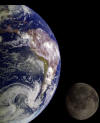 |
|
||||
|
|
|||||
|
|
|
|
|
||
| ||||||||||||||||
|
(Wiley, April 2003) For thousands of years, the Moon has played a role in the culture, mythology, and religions of people across the world. In a more practical sense, it has served as a torch for travelers, a location finder for mariners, and a timekeeper for civilizations. But only in the last 400 years have we begun to look at the Moon through the eyes of modern experimental science, and only in the last twenty years has a coherent – and surprisingly little-known – theory emerged about its origin. In The Big Splat, science writer Dana Mackenzie narrates an engaging history of one of the most important recent breakthroughs in planetary astronomy. He also tells the tale of a calamity of unimaginable proportions that took place some four and a half billion years ago – an event that had a more profound effect on our planet than any other in Earth's history ... even the meteorite impact that killed the dinosaurs. The Big Splat traces the emergence of the three most popular lunar creation stories before the Apollo missions. In one version, the Moon was flung off by the proto-Earth's rapid rotation, perhaps leaving the Pacific Ocean behind as a scar. Another theory held that it formed independently of Earth, and was subsequently captured by Earth's gravity. Yet a third suggested that the Moon and Earth formed at the same time, out of the same nebula of gas and dust. Mackenzie introduces us to the often colorful characters who championed each theory. None of the three survived the test of the Apollo missions, yet paradoxically all three of them contributed to the consensus that has emerged since the return of the Apollo astronauts. Taking us on an engaging tour through a solar system that once looked very different from the one we know today, Mackenzie explains how the pieces of the lunar puzzle finally came together in an explosive theory that has rocked planetary science. A doomed planet, now called Theia, collided with Earth around 50 million years after the solar system began, and the remains of this giant inferno – the Big Splat – coalesced to form our now peaceful Moon. Through fascinating historical accounts of the work of scientists, from the joy of Kepler on hearing of Galileo's telescopic discoveries, to the dogged persistence of George Darwin (son of Charles) working out the tidal evolution of the Moon's orbit, Mackenzie shows that the struggle to understand the Moon's history is also a profoundly human story. As Mackenzie writes, The Big Splat is above all "about the long lineage of intellectual voyagers who began exploring the Moon long before Neil Armstrong planted his boot into the lunar dust." Relating the fascinating history of lunar speculation and underscoring its important place in the scientific universe, The Big Splat gives us a new appreciation for the beautiful and enigmatic world that illuminates our nights. We'll never look at the Moon in quite the same way again. (From the John Wiley & Sons press release, slightly revised) The Big Splat is now available at a bookstore near you, or it can be purchased online at www.wiley.com or www.amazon.com. Go to:
Last modified: November 27, 2003 |